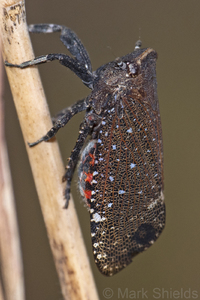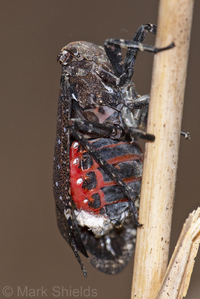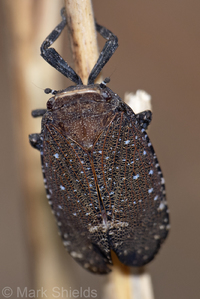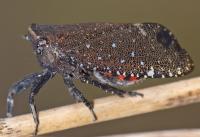
|
|
|
| synonym |
|
| description |
A dark species, almost black in color, with small white speckling on the wings. The head is short but broad and has a yellow margin to the flat edge; the eyes are equal in separation or broader than the pronotum, but not exceeding the width of the closed forewings (UDEL). The thorax and anterior abominal segments are black, while the posterior abdominal segments (most of the abdomen) are a bright red: see here. A large species, adults are 8-17 mm long. For more on the description of this species, see: Bartlett et al., 2025.
Nymphs have a vertex (top of the head) that, in the 5th instar stage, is at least 8 times wider than long. Nymphs are grayish overall, with blackish legs, a dark brownish thorax, and a whitish abdomen and head that contrasts with the darker body. There are bumps/spike-like projections across the body. (T. Hagerty) |
| distribution |
Eastern United States, as far north as Maryland, west to Texas; also found in neighboring Mexico. (Bartlett et al., 2025) |
| abundance |
Uncommon to rare, not encountered frequently; recorded from a handful of counties in the eastern Piedmont and Coastal Plain. |
| seasonal_occurrence | |
| habitat |
Often found in clear-cut areas, such as roads and powerlines; can also be found in semi-forested areas (T. Hagerty). |
| plant associates |
Rhus spp., especially Rhus copallinum (winged sumac, Anacardiaceae). Also reported from Abrosia trifida and Acer rubrum. (Bartlett et al., 2025) |
| behavior |
Very hard to capture, this species is an expert at jumping. It is typically found on the main trunk of host plants but sometimes on the branches or nearby plants. Nymphs like to occur near the base of the host plant and prefer to be on individuals in which the base of the tree is hidden by other vegetation. This species is very selective about the plants it chooses, with most winged-sumac in the area lacking any individuals; but on favored trees, you can find a number of adult and nymph fuliginosa. Additionally, this species is a messy feeder in both the nymphal and adult stage, leaving behind some sap flow from seeping wounds on selected sumac trees; these wounds then turn into nodules in subsequent years. (Bartlett et al., 2025) |
| comments |
The eggs are believed to hatch as early as May (T. Hagerty). The species is a univoltine species, with five nymphal instars and adults starting to appear in July (at least in North Carolina). Eggs are laid in rows that are covered by a grayish-pink foam waxy covering. (Bartlett et al., 2025) |
status |
[Native:]
[Introduced:]
[Extirpated:] | | list_type |
[Official:]
[Provisional:] |
| adult_id | Unmistakable and widely known Identifiable from good quality photos of unworn specimens
Identifiable from photos showing undersides, or other specialized views [e.g., legs, face]
Identifiable only by close inspection of structural features or by DNA analysis NULL |
| nymph_id | Unmistakable and widely known Identifiable from good quality photos, especially where associated with known host plants
Identifiable from close inspection of specimens or by DNA analysis
Identifiable only through rearing to adulthood NULL |
| G_rank |
|
| S_rank |
|
| rank_comments |
|
| tribe |
Poiocerini |
| subgenus |
|
Species Photo Gallery for Poblicia fuliginosa Sumac Speckled Lanternfly |
 | Photo by: F. Williams, S. Williams
Gates Co.
Comment: MEMI - On winged sumac |  | Photo by: Steve Hall
Bladen Co.
Comment: |
 | Photo by: Mark Shields
Onslow Co.
Comment: |  | Photo by: Mark Shields
Onslow Co.
Comment: |
 | Photo by: Mark Shields
Onslow Co.
Comment: |  | Photo by: Mark Shields
Onslow Co.
Comment: |
 | Photo by: F. Williams, S. Williams
Gates Co.
Comment: MEMI |

 »
»


 »
»
